Advanced 2-dimensional spectra processing.
This class contains advanced spectra processing functions.
The algorithms in this class have been published in the following references:
These NIM papers are also available as doc or ps files from:
See also the online documentation and tutorials.
All the figures in this page were prepared using the DaqProVis system, Data Acquisition, Processing and Visualization system, developed at the Institute of Physics, Slovak Academy of Sciences, Bratislava, Slovakia.
Definition at line 18 of file TSpectrum2.h.
Public Types | |
| enum | { kBackIncreasingWindow =0 , kBackDecreasingWindow =1 , kBackSuccessiveFiltering =0 , kBackOneStepFiltering =1 } |
 Public Types inherited from TObject Public Types inherited from TObject | |
| enum | { kIsOnHeap = 0x01000000 , kNotDeleted = 0x02000000 , kZombie = 0x04000000 , kInconsistent = 0x08000000 , kBitMask = 0x00ffffff } |
| enum | { kSingleKey = (1ULL << ( 0 )) , kOverwrite = (1ULL << ( 1 )) , kWriteDelete = (1ULL << ( 2 )) } |
| enum | EDeprecatedStatusBits { kObjInCanvas = (1ULL << ( 3 )) } |
| enum | EStatusBits { kCanDelete = (1ULL << ( 0 )) , kMustCleanup = (1ULL << ( 3 )) , kIsReferenced = (1ULL << ( 4 )) , kHasUUID = (1ULL << ( 5 )) , kCannotPick = (1ULL << ( 6 )) , kNoContextMenu = (1ULL << ( 8 )) , kInvalidObject = (1ULL << ( 13 )) } |
Public Member Functions | |
| TSpectrum2 () | |
| Constructor. | |
| TSpectrum2 (Int_t maxpositions, Double_t resolution=1) | |
| ~TSpectrum2 () override | |
| Destructor. | |
| virtual TH1 * | Background (const TH1 *hist, Int_t nIterX=20, Int_t nIterY=20, Option_t *option="") |
| This function calculates the background spectrum in the input histogram h. | |
| const char * | Background (Double_t **spectrum, Int_t ssizex, Int_t ssizey, Int_t numberIterationsX, Int_t numberIterationsY, Int_t direction, Int_t filterType) |
| This function calculates background spectrum from source spectrum. | |
| const char * | Deconvolution (Double_t **source, Double_t **resp, Int_t ssizex, Int_t ssizey, Int_t numberIterations, Int_t numberRepetitions, Double_t boost) |
| This function calculates deconvolution from source spectrum according to response spectrum The result is placed in the matrix pointed by source pointer. | |
| TH1 * | GetHistogram () const |
| Int_t | GetNPeaks () const |
| Double_t * | GetPositionX () const |
| Double_t * | GetPositionY () const |
| TClass * | IsA () const override |
| void | Print (Option_t *option="") const override |
| Print the array of positions. | |
| virtual Int_t | Search (const TH1 *hist, Double_t sigma=2, Option_t *option="", Double_t threshold=0.05) |
| This function searches for peaks in source spectrum in hin The number of found peaks and their positions are written into the members fNpeaks and fPositionX. | |
| Int_t | SearchHighRes (Double_t **source, Double_t **dest, Int_t ssizex, Int_t ssizey, Double_t sigma, Double_t threshold, Bool_t backgroundRemove, Int_t deconIterations, Bool_t markov, Int_t averWindow) |
| This function searches for peaks in source spectrum It is based on deconvolution method. | |
| void | SetResolution (Double_t resolution=1) |
| NOT USED resolution: determines resolution of the neighboring peaks default value is 1 correspond to 3 sigma distance between peaks. | |
| const char * | SmoothMarkov (Double_t **source, Int_t ssizex, Int_t ssizey, Int_t averWindow) |
| This function calculates smoothed spectrum from source spectrum based on Markov chain method. | |
| void | Streamer (TBuffer &) override |
| Stream an object of class TObject. | |
| void | StreamerNVirtual (TBuffer &ClassDef_StreamerNVirtual_b) |
 Public Member Functions inherited from TNamed Public Member Functions inherited from TNamed | |
| TNamed () | |
| TNamed (const char *name, const char *title) | |
| TNamed (const TNamed &named) | |
| TNamed copy ctor. | |
| TNamed (const TString &name, const TString &title) | |
| virtual | ~TNamed () |
| TNamed destructor. | |
| void | Clear (Option_t *option="") override |
| Set name and title to empty strings (""). | |
| TObject * | Clone (const char *newname="") const override |
| Make a clone of an object using the Streamer facility. | |
| Int_t | Compare (const TObject *obj) const override |
| Compare two TNamed objects. | |
| void | Copy (TObject &named) const override |
| Copy this to obj. | |
| virtual void | FillBuffer (char *&buffer) |
| Encode TNamed into output buffer. | |
| const char * | GetName () const override |
| Returns name of object. | |
| const char * | GetTitle () const override |
| Returns title of object. | |
| ULong_t | Hash () const override |
| Return hash value for this object. | |
| Bool_t | IsSortable () const override |
| void | ls (Option_t *option="") const override |
| List TNamed name and title. | |
| TNamed & | operator= (const TNamed &rhs) |
| TNamed assignment operator. | |
| virtual void | SetName (const char *name) |
| Set the name of the TNamed. | |
| virtual void | SetNameTitle (const char *name, const char *title) |
| Set all the TNamed parameters (name and title). | |
| virtual void | SetTitle (const char *title="") |
| Set the title of the TNamed. | |
| virtual Int_t | Sizeof () const |
| Return size of the TNamed part of the TObject. | |
| void | StreamerNVirtual (TBuffer &ClassDef_StreamerNVirtual_b) |
 Public Member Functions inherited from TObject Public Member Functions inherited from TObject | |
| TObject () | |
| TObject constructor. | |
| TObject (const TObject &object) noexcept | |
| TObject copy ctor. | |
| virtual | ~TObject () |
| TObject destructor. | |
| void | AbstractMethod (const char *method) const |
| Call this function within a function that you don't want to define as purely virtual, in order not to force all users deriving from that class to implement that maybe (on their side) unused function; but at the same time, emit a run-time warning if they try to call it, telling that it is not implemented in the derived class: action must thus be taken on the user side to override it. | |
| virtual void | AppendPad (Option_t *option="") |
| Append graphics object to current pad. | |
| virtual void | Browse (TBrowser *b) |
| Browse object. May be overridden for another default action. | |
| ULong_t | CheckedHash () |
| Check and record whether this class has a consistent Hash/RecursiveRemove setup (*) and then return the regular Hash value for this object. | |
| virtual const char * | ClassName () const |
| Returns name of class to which the object belongs. | |
| virtual void | Delete (Option_t *option="") |
| Delete this object. | |
| virtual Int_t | DistancetoPrimitive (Int_t px, Int_t py) |
| Computes distance from point (px,py) to the object. | |
| virtual void | Draw (Option_t *option="") |
| Default Draw method for all objects. | |
| virtual void | DrawClass () const |
| Draw class inheritance tree of the class to which this object belongs. | |
| virtual TObject * | DrawClone (Option_t *option="") const |
Draw a clone of this object in the current selected pad with: gROOT->SetSelectedPad(c1). | |
| virtual void | Dump () const |
| Dump contents of object on stdout. | |
| virtual void | Error (const char *method, const char *msgfmt,...) const |
| Issue error message. | |
| virtual void | Execute (const char *method, const char *params, Int_t *error=nullptr) |
| Execute method on this object with the given parameter string, e.g. | |
| virtual void | Execute (TMethod *method, TObjArray *params, Int_t *error=nullptr) |
| Execute method on this object with parameters stored in the TObjArray. | |
| virtual void | ExecuteEvent (Int_t event, Int_t px, Int_t py) |
| Execute action corresponding to an event at (px,py). | |
| virtual void | Fatal (const char *method, const char *msgfmt,...) const |
| Issue fatal error message. | |
| virtual TObject * | FindObject (const char *name) const |
| Must be redefined in derived classes. | |
| virtual TObject * | FindObject (const TObject *obj) const |
| Must be redefined in derived classes. | |
| virtual Option_t * | GetDrawOption () const |
| Get option used by the graphics system to draw this object. | |
| virtual const char * | GetIconName () const |
| Returns mime type name of object. | |
| virtual char * | GetObjectInfo (Int_t px, Int_t py) const |
| Returns string containing info about the object at position (px,py). | |
| virtual Option_t * | GetOption () const |
| virtual UInt_t | GetUniqueID () const |
| Return the unique object id. | |
| virtual Bool_t | HandleTimer (TTimer *timer) |
| Execute action in response of a timer timing out. | |
| Bool_t | HasInconsistentHash () const |
| Return true is the type of this object is known to have an inconsistent setup for Hash and RecursiveRemove (i.e. | |
| virtual void | Info (const char *method, const char *msgfmt,...) const |
| Issue info message. | |
| virtual Bool_t | InheritsFrom (const char *classname) const |
| Returns kTRUE if object inherits from class "classname". | |
| virtual Bool_t | InheritsFrom (const TClass *cl) const |
| Returns kTRUE if object inherits from TClass cl. | |
| virtual void | Inspect () const |
| Dump contents of this object in a graphics canvas. | |
| void | InvertBit (UInt_t f) |
| Bool_t | IsDestructed () const |
| IsDestructed. | |
| virtual Bool_t | IsEqual (const TObject *obj) const |
| Default equal comparison (objects are equal if they have the same address in memory). | |
| virtual Bool_t | IsFolder () const |
| Returns kTRUE in case object contains browsable objects (like containers or lists of other objects). | |
| R__ALWAYS_INLINE Bool_t | IsOnHeap () const |
| R__ALWAYS_INLINE Bool_t | IsZombie () const |
| void | MayNotUse (const char *method) const |
| Use this method to signal that a method (defined in a base class) may not be called in a derived class (in principle against good design since a child class should not provide less functionality than its parent, however, sometimes it is necessary). | |
| virtual Bool_t | Notify () |
| This method must be overridden to handle object notification (the base implementation is no-op). | |
| void | Obsolete (const char *method, const char *asOfVers, const char *removedFromVers) const |
| Use this method to declare a method obsolete. | |
| void | operator delete (void *, size_t) |
| Operator delete for sized deallocation. | |
| void | operator delete (void *ptr) |
| Operator delete. | |
| void | operator delete (void *ptr, void *vp) |
| Only called by placement new when throwing an exception. | |
| void | operator delete[] (void *, size_t) |
| Operator delete [] for sized deallocation. | |
| void | operator delete[] (void *ptr) |
| Operator delete []. | |
| void | operator delete[] (void *ptr, void *vp) |
| Only called by placement new[] when throwing an exception. | |
| void * | operator new (size_t sz) |
| void * | operator new (size_t sz, void *vp) |
| void * | operator new[] (size_t sz) |
| void * | operator new[] (size_t sz, void *vp) |
| TObject & | operator= (const TObject &rhs) noexcept |
| TObject assignment operator. | |
| virtual void | Paint (Option_t *option="") |
| This method must be overridden if a class wants to paint itself. | |
| virtual void | Pop () |
| Pop on object drawn in a pad to the top of the display list. | |
| virtual Int_t | Read (const char *name) |
| Read contents of object with specified name from the current directory. | |
| virtual void | RecursiveRemove (TObject *obj) |
| Recursively remove this object from a list. | |
| void | ResetBit (UInt_t f) |
| virtual void | SaveAs (const char *filename="", Option_t *option="") const |
| Save this object in the file specified by filename. | |
| virtual void | SavePrimitive (std::ostream &out, Option_t *option="") |
| Save a primitive as a C++ statement(s) on output stream "out". | |
| void | SetBit (UInt_t f) |
| void | SetBit (UInt_t f, Bool_t set) |
| Set or unset the user status bits as specified in f. | |
| virtual void | SetDrawOption (Option_t *option="") |
| Set drawing option for object. | |
| virtual void | SetUniqueID (UInt_t uid) |
| Set the unique object id. | |
| void | StreamerNVirtual (TBuffer &ClassDef_StreamerNVirtual_b) |
| virtual void | SysError (const char *method, const char *msgfmt,...) const |
| Issue system error message. | |
| R__ALWAYS_INLINE Bool_t | TestBit (UInt_t f) const |
| Int_t | TestBits (UInt_t f) const |
| virtual void | UseCurrentStyle () |
| Set current style settings in this object This function is called when either TCanvas::UseCurrentStyle or TROOT::ForceStyle have been invoked. | |
| virtual void | Warning (const char *method, const char *msgfmt,...) const |
| Issue warning message. | |
| virtual Int_t | Write (const char *name=nullptr, Int_t option=0, Int_t bufsize=0) |
| Write this object to the current directory. | |
| virtual Int_t | Write (const char *name=nullptr, Int_t option=0, Int_t bufsize=0) const |
| Write this object to the current directory. | |
Static Public Member Functions | |
| static TClass * | Class () |
| static const char * | Class_Name () |
| static constexpr Version_t | Class_Version () |
| static const char * | DeclFileName () |
| static void | SetAverageWindow (Int_t w=3) |
| static function: Set average window of searched peaks see TSpectrum2::SearchHighRes | |
| static void | SetDeconIterations (Int_t n=3) |
| static function: Set max number of decon iterations in deconvolution operation see TSpectrum2::SearchHighRes | |
| static TH1 * | StaticBackground (const TH1 *hist, Int_t nIterX=20, Int_t nIterY=20, Option_t *option="") |
| static function (called by TH2), interface to TSpectrum2::Background | |
| static Int_t | StaticSearch (const TH1 *hist, Double_t sigma=2, Option_t *option="goff", Double_t threshold=0.05) |
| static function (called by TH2), interface to TSpectrum2::Search | |
 Static Public Member Functions inherited from TNamed Static Public Member Functions inherited from TNamed | |
| static TClass * | Class () |
| static const char * | Class_Name () |
| static constexpr Version_t | Class_Version () |
| static const char * | DeclFileName () |
 Static Public Member Functions inherited from TObject Static Public Member Functions inherited from TObject | |
| static TClass * | Class () |
| static const char * | Class_Name () |
| static constexpr Version_t | Class_Version () |
| static const char * | DeclFileName () |
| static Longptr_t | GetDtorOnly () |
| Return destructor only flag. | |
| static Bool_t | GetObjectStat () |
| Get status of object stat flag. | |
| static void | SetDtorOnly (void *obj) |
| Set destructor only flag. | |
| static void | SetObjectStat (Bool_t stat) |
| Turn on/off tracking of objects in the TObjectTable. | |
Protected Attributes | |
| TH1 * | fHistogram |
| resulting histogram | |
| Int_t | fMaxPeaks |
| Maximum number of peaks to be found. | |
| Int_t | fNPeaks |
| number of peaks found | |
| Double_t * | fPosition |
| [fNPeaks] array of current peak positions | |
| Double_t * | fPositionX |
| [fNPeaks] X position of peaks | |
| Double_t * | fPositionY |
| [fNPeaks] Y position of peaks | |
| Double_t | fResolution |
| NOT USED resolution of the neighboring peaks | |
 Protected Attributes inherited from TNamed Protected Attributes inherited from TNamed | |
| TString | fName |
| TString | fTitle |
Static Protected Attributes | |
| static Int_t | fgAverageWindow = 3 |
| Average window of searched peaks. | |
| static Int_t | fgIterations = 3 |
| Maximum number of decon iterations (default=3) | |
Additional Inherited Members | |
 Protected Types inherited from TObject Protected Types inherited from TObject | |
| enum | { kOnlyPrepStep = (1ULL << ( 3 )) } |
 Protected Member Functions inherited from TNamed Protected Member Functions inherited from TNamed | |
| void | SavePrimitiveNameTitle (std::ostream &out, const char *variable_name) |
| Save object name and title into the output stream "out". | |
 Protected Member Functions inherited from TObject Protected Member Functions inherited from TObject | |
| virtual void | DoError (int level, const char *location, const char *fmt, va_list va) const |
| Interface to ErrorHandler (protected). | |
| void | MakeZombie () |
 Static Protected Member Functions inherited from TObject Static Protected Member Functions inherited from TObject | |
| static void | SavePrimitiveConstructor (std::ostream &out, TClass *cl, const char *variable_name, const char *constructor_agrs="", Bool_t empty_line=kTRUE) |
| Save object constructor in the output stream "out". | |
| static void | SavePrimitiveDraw (std::ostream &out, const char *variable_name, Option_t *option=nullptr) |
| Save invocation of primitive Draw() method Skipped if option contains "nodraw" string. | |
| static TString | SavePrimitiveVector (std::ostream &out, const char *prefix, Int_t len, Double_t *arr, Int_t flag=0) |
| Save array in the output stream "out" as vector. | |
#include <TSpectrum2.h>
| Enumerator | |
|---|---|
| kBackIncreasingWindow | |
| kBackDecreasingWindow | |
| kBackSuccessiveFiltering | |
| kBackOneStepFiltering | |
Definition at line 31 of file TSpectrum2.h.
| TSpectrum2::TSpectrum2 | ( | ) |
Constructor.
Definition at line 59 of file TSpectrum2.cxx.
Definition at line 79 of file TSpectrum2.cxx.
|
override |
Destructor.
Definition at line 94 of file TSpectrum2.cxx.
|
virtual |
This function calculates the background spectrum in the input histogram h.
The background is returned as a histogram.
Function parameters:
NOTE that the background is only evaluated in the current range of h. ie, if h has a bin range (set via h->GetXaxis()->SetRange(binmin,binmax), the returned histogram will be created with the same number of bins as the input histogram h, but only bins from binmin to binmax will be filled with the estimated background.
Definition at line 144 of file TSpectrum2.cxx.
| const char * TSpectrum2::Background | ( | Double_t ** | spectrum, |
| Int_t | ssizex, | ||
| Int_t | ssizey, | ||
| Int_t | numberIterationsX, | ||
| Int_t | numberIterationsY, | ||
| Int_t | direction, | ||
| Int_t | filterType ) |
This function calculates background spectrum from source spectrum.
The result is placed to the array pointed by spectrum pointer.
Function parameters:
Goal: Separation of useful information (peaks) from useless information (background)
Algorithm based on Successive Comparisons:
It is an extension of one-dimensional SNIP algorithm to another dimension. For details we refer to [2].
Algorithm based on One Step Filtering:
New value in the estimated channel is calculated as:
\[ a = \nu_{p-1}(i_1,i_2)\]
\[ b = \frac{\nu_{p-1}(i_1-p,i_2-p) - 2\nu_{p-1}(i_1-p,i_2) + \nu_{p-1}(i_1-p,i_2+p) - 2\nu_{p-1}(i_1,i_2-p)}{4} + \]
\[ \frac{-2\nu_{p-1}(i_1,i_2+p) + \nu_{p-1}(i_1+p,i_2-p) - 2\nu_{p-1}(i_1+p,i_2) + \nu_{p-1}(i_1+p,i_2+p)}{4} \]
\[ \nu_{p-1}(i_1,i_2) = min(a,b)\]
where p = 1, 2, ..., number_of_iterations.
[1] C. G Ryan et al.: SNIP, a statistics-sensitive background treatment for the quantitative analysis of PIXE spectra in geoscience applications. NIM, B34 (1988), 396-402.
[2] M. Morhac;, J. Kliman, V. Matouoek, M. Veselsky, I. Turzo.: Background elimination methods for multidimensional gamma-ray spectra. NIM, A401 (1997) 113-132.

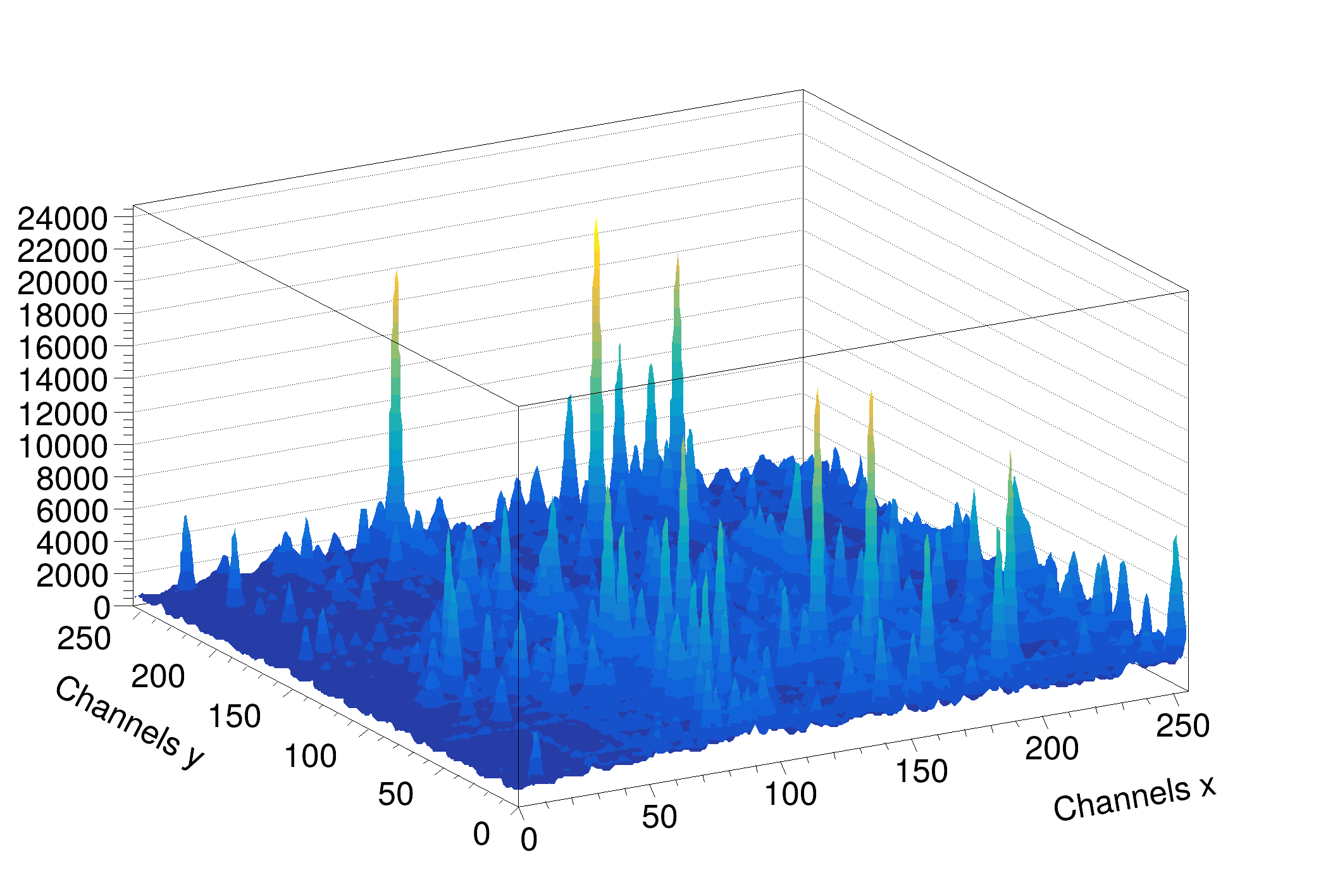

Definition at line 411 of file TSpectrum2.cxx.
Definition at line 61 of file TSpectrum2.h.
Definition at line 61 of file TSpectrum2.h.
| const char * TSpectrum2::Deconvolution | ( | Double_t ** | source, |
| Double_t ** | resp, | ||
| Int_t | ssizex, | ||
| Int_t | ssizey, | ||
| Int_t | numberIterations, | ||
| Int_t | numberRepetitions, | ||
| Double_t | boost ) |
This function calculates deconvolution from source spectrum according to response spectrum The result is placed in the matrix pointed by source pointer.
Function parameters:
Goal: Improvement of the resolution in spectra, decomposition of multiplets
Mathematical formulation of the 2-dimensional convolution system is
\[ y(i_1,i_2) = \sum_{k_1=0}^{N_1-1} \sum_{k_2=0}^{N_2-1} h(i_1-k_1,i_2-k_2)x(k_1,k_2) \]
\[ i_1 = 0,1,2, ... ,N_1-1, i_2 = 0,1,2, ... ,N_2-1 \]
where h(i,j) is the impulse response function, x, y are input and output matrices, respectively, \( N_1, N_2\) are the lengths of x and h matrices
[1] M. Morhac;, J. Kliman, V. Matouoek, M. Veselsky, I. Turzo.: Efficient one- and two-dimensional Gold deconvolution and its application to gamma-ray spectra decomposition. NIM, A401 (1997) 385-408.
[2] Morhac; M., Matouoek V., Kliman J., Efficient algorithm of multidimensional deconvolution and its application to nuclear data processing, Digital Signal Processing 13 (2003) 144.

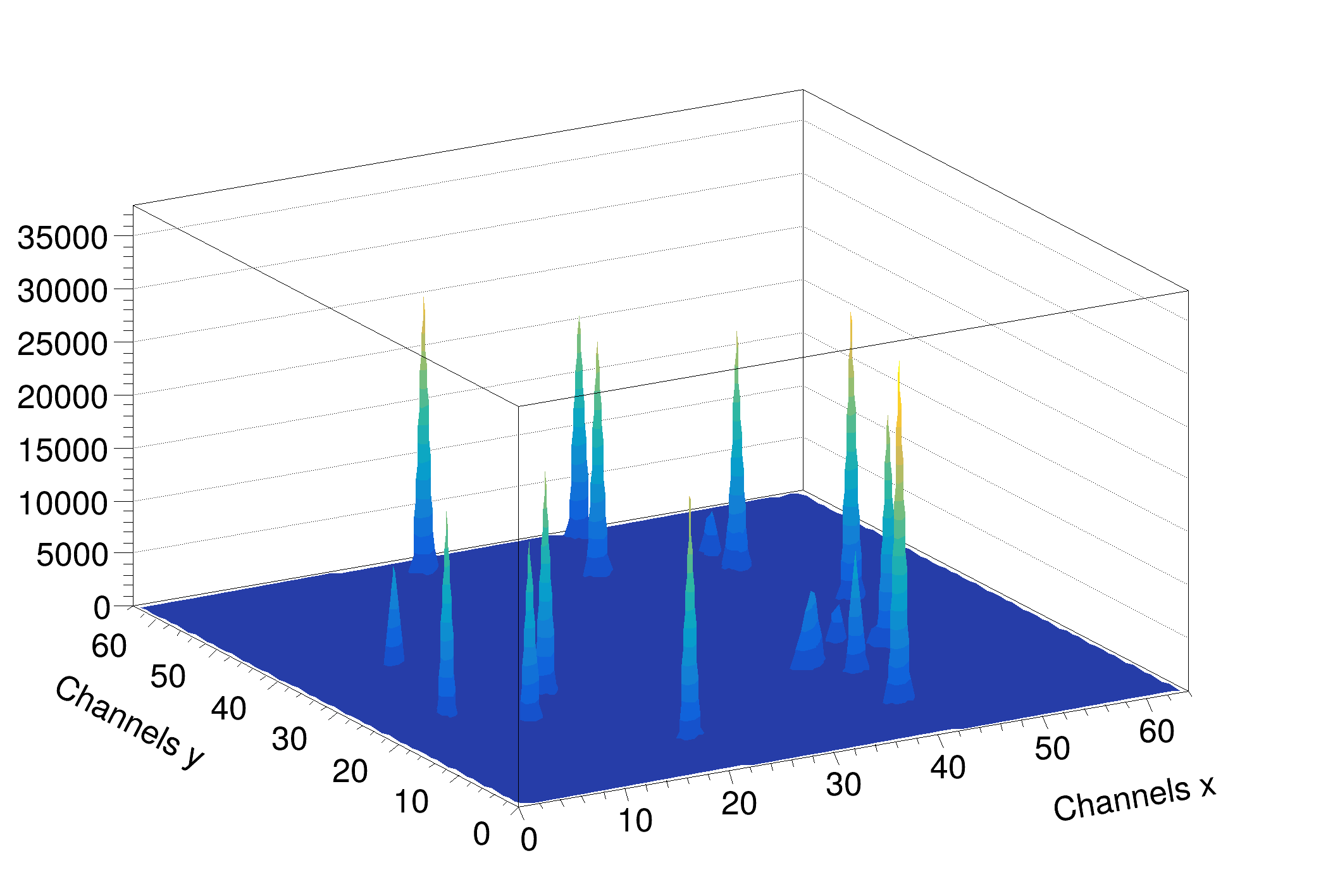
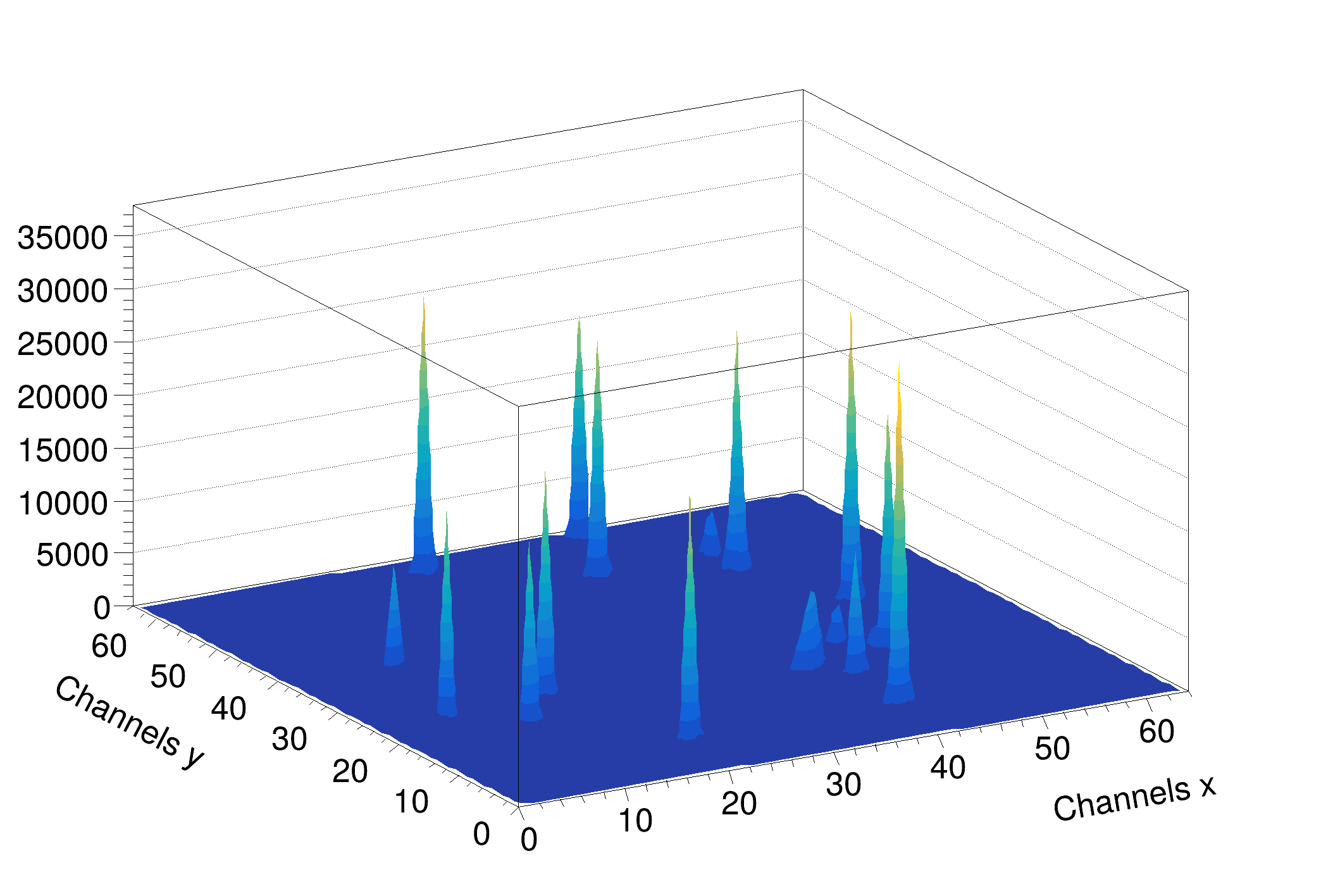
Definition at line 877 of file TSpectrum2.cxx.
|
inline |
Definition at line 42 of file TSpectrum2.h.
|
inline |
Definition at line 43 of file TSpectrum2.h.
|
inline |
Definition at line 44 of file TSpectrum2.h.
|
inline |
Definition at line 45 of file TSpectrum2.h.
|
inlineoverridevirtual |
Reimplemented from TNamed.
Definition at line 61 of file TSpectrum2.h.
|
overridevirtual |
Print the array of positions.
Reimplemented from TNamed.
Definition at line 210 of file TSpectrum2.cxx.
|
virtual |
This function searches for peaks in source spectrum in hin The number of found peaks and their positions are written into the members fNpeaks and fPositionX.
The search is performed in the current histogram range.
Function parameters:
threshold: (default=0.05) peaks with amplitude less than threshold*highest_peak are discarded. 0<threshold<1
By default, the background is removed before deconvolution. Specify the option "nobackground" to not remove the background.
By default the "Markov" chain algorithm is used. Specify the option "noMarkov" to disable this algorithm Note that by default the source spectrum is replaced by a new spectrum
By default a polymarker object is created and added to the list of functions of the histogram. The histogram is drawn with the specified option and the polymarker object drawn on top of the histogram. The polymarker coordinates correspond to the npeaks peaks found in the histogram. A pointer to the polymarker object can be retrieved later via:
Specify the option "goff" to disable the storage and drawing of the polymarker.
Definition at line 250 of file TSpectrum2.cxx.
| Int_t TSpectrum2::SearchHighRes | ( | Double_t ** | source, |
| Double_t ** | dest, | ||
| Int_t | ssizex, | ||
| Int_t | ssizey, | ||
| Double_t | sigma, | ||
| Double_t | threshold, | ||
| Bool_t | backgroundRemove, | ||
| Int_t | deconIterations, | ||
| Bool_t | markov, | ||
| Int_t | averWindow ) |
This function searches for peaks in source spectrum It is based on deconvolution method.
First the background is removed (if desired), then Markov spectrum is calculated (if desired), then the response function is generated according to given sigma and deconvolution is carried out.
Function parameters:
Goal: to identify automatically the peaks in spectrum with the presence of the continuous background, one-fold coincidences (ridges) and statistical fluctuations - noise.
The common problems connected with correct peak identification in two-dimensional coincidence spectra are
[1] M.A. Mariscotti: A method for identification of peaks in the presence of background and its application to spectrum analysis. NIM 50 (1967), 309-320.
[2] M. Morhac;, J. Kliman, V. Matouoek, M. Veselsky, I. Turzo.:Identification of peaks in multidimensional coincidence gamma-ray spectra. NIM, A443 (2000) 108-125.
[3] Z.K. Silagadze, A new algorithm for automatic photopeak searches. NIM A 376 (1996), 451.
SearchHighRes function provides users with the possibility to vary the input parameters and with the access to the output deconvolved data in the destination spectrum. Based on the output data one can tune the parameters.
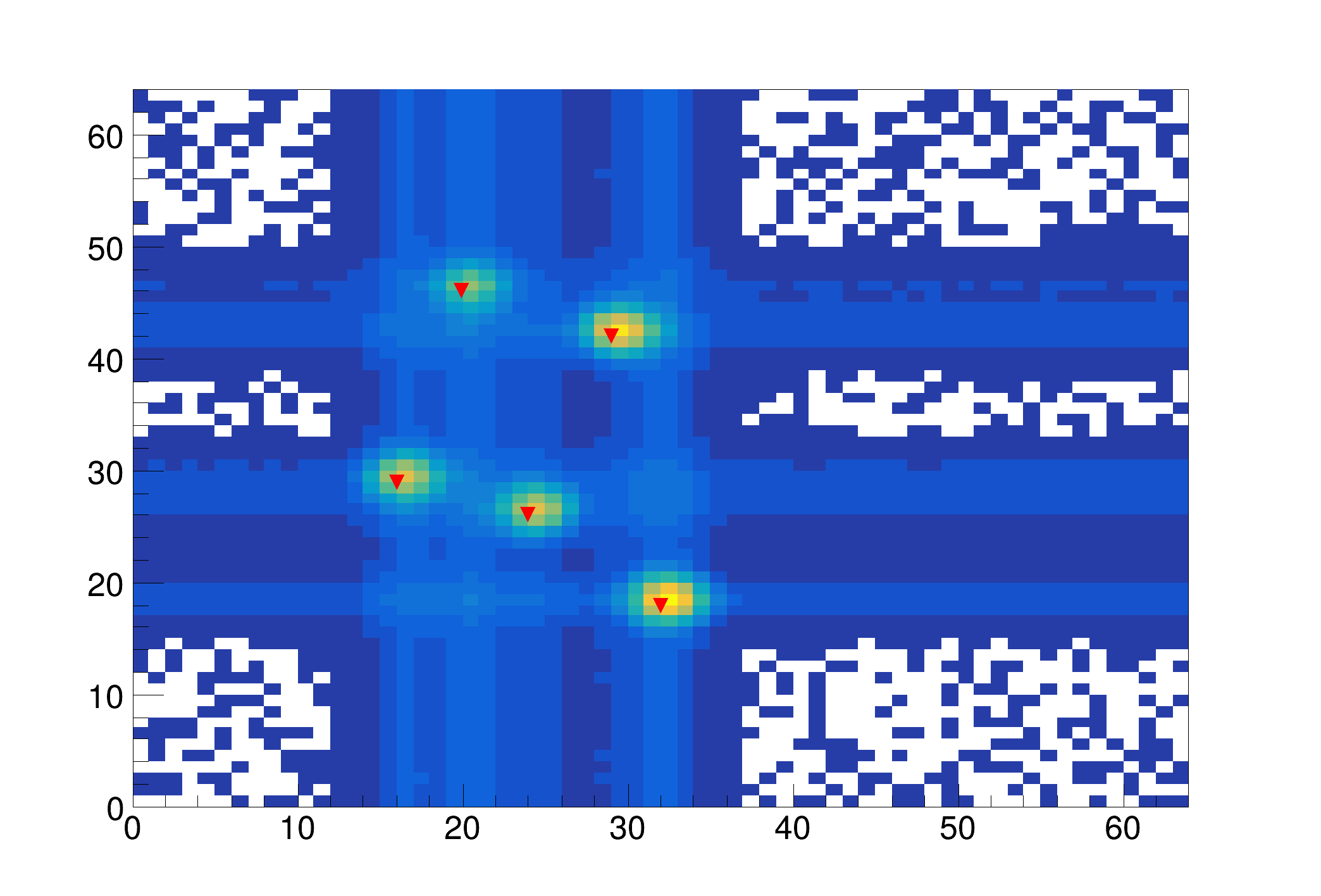
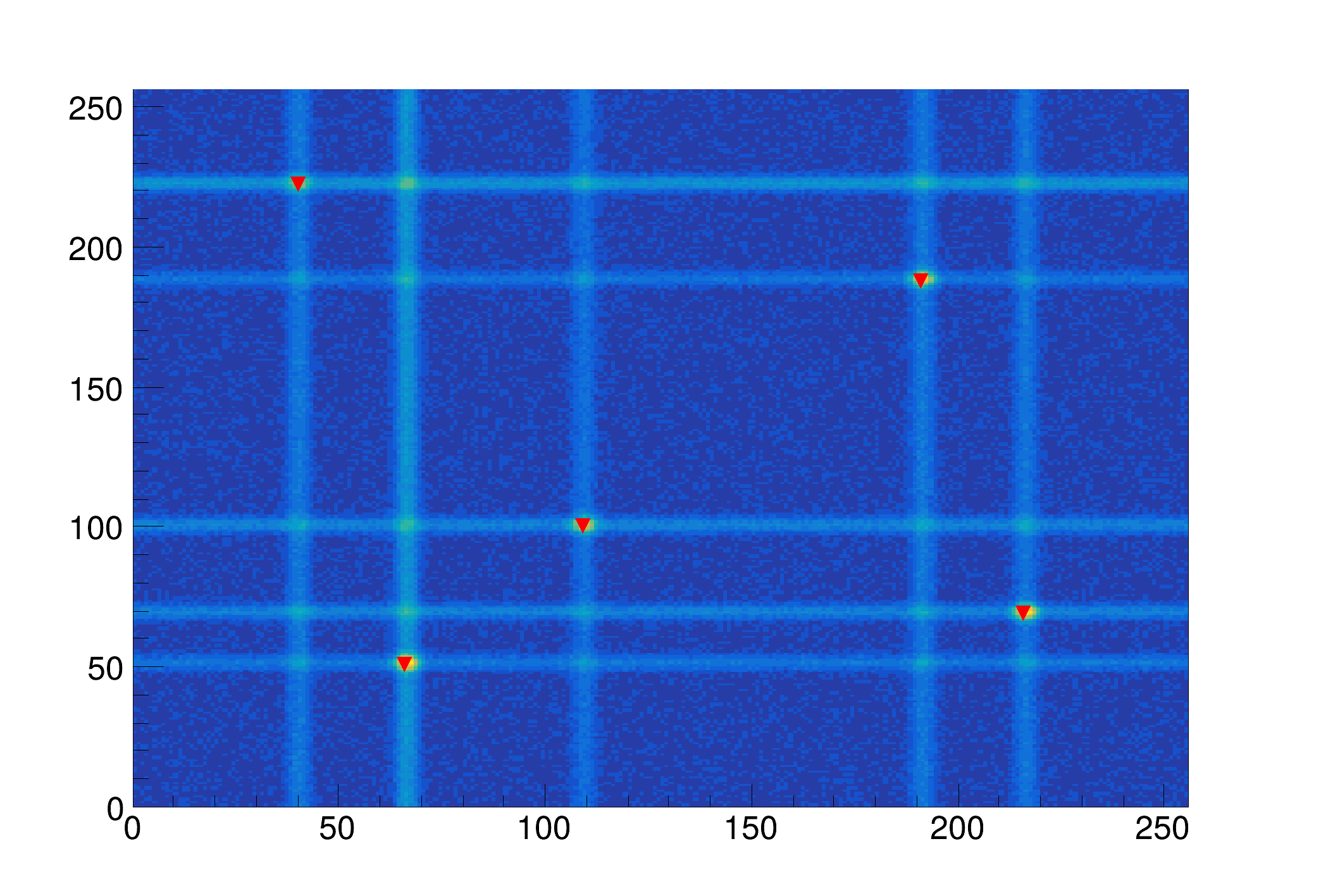
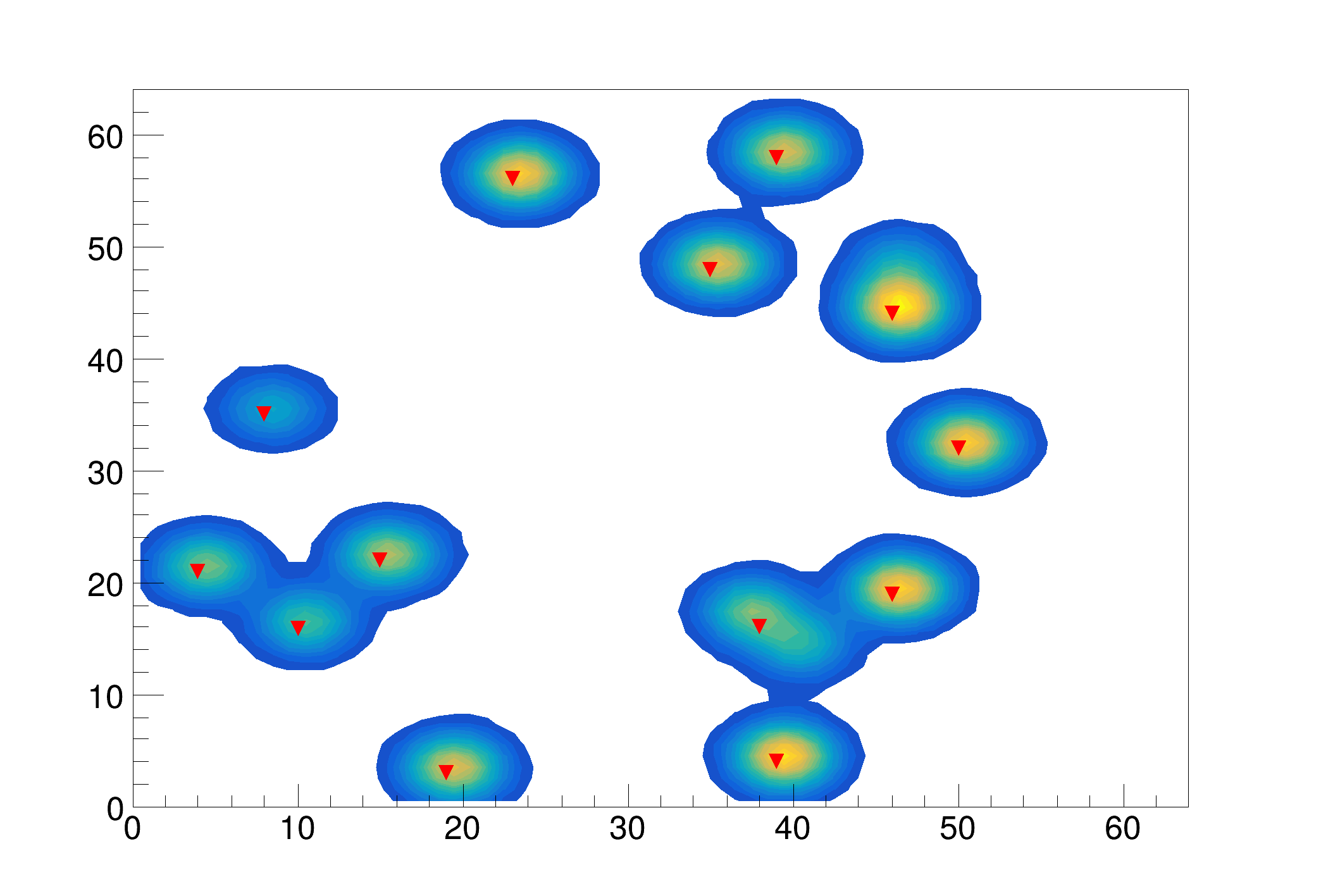
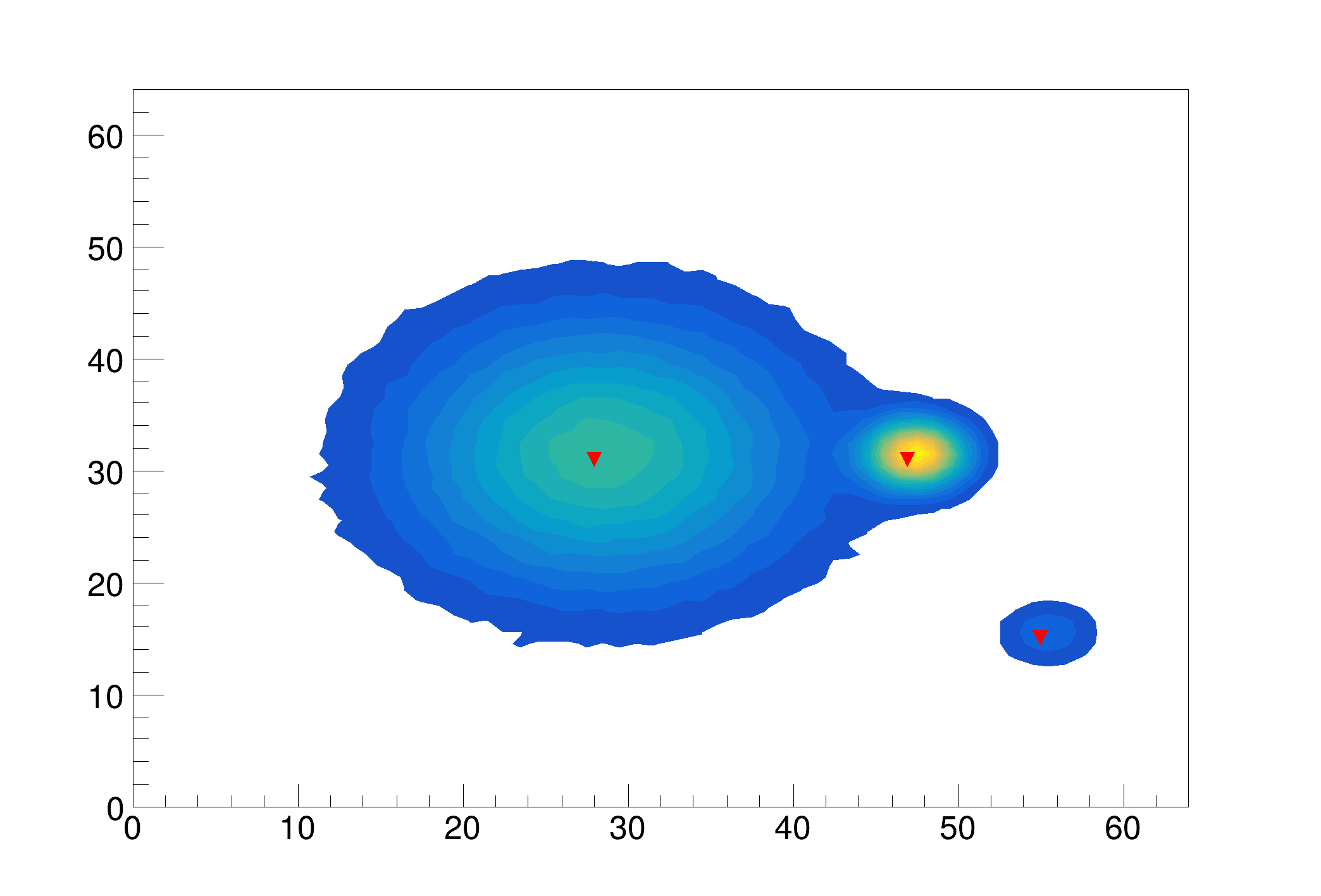
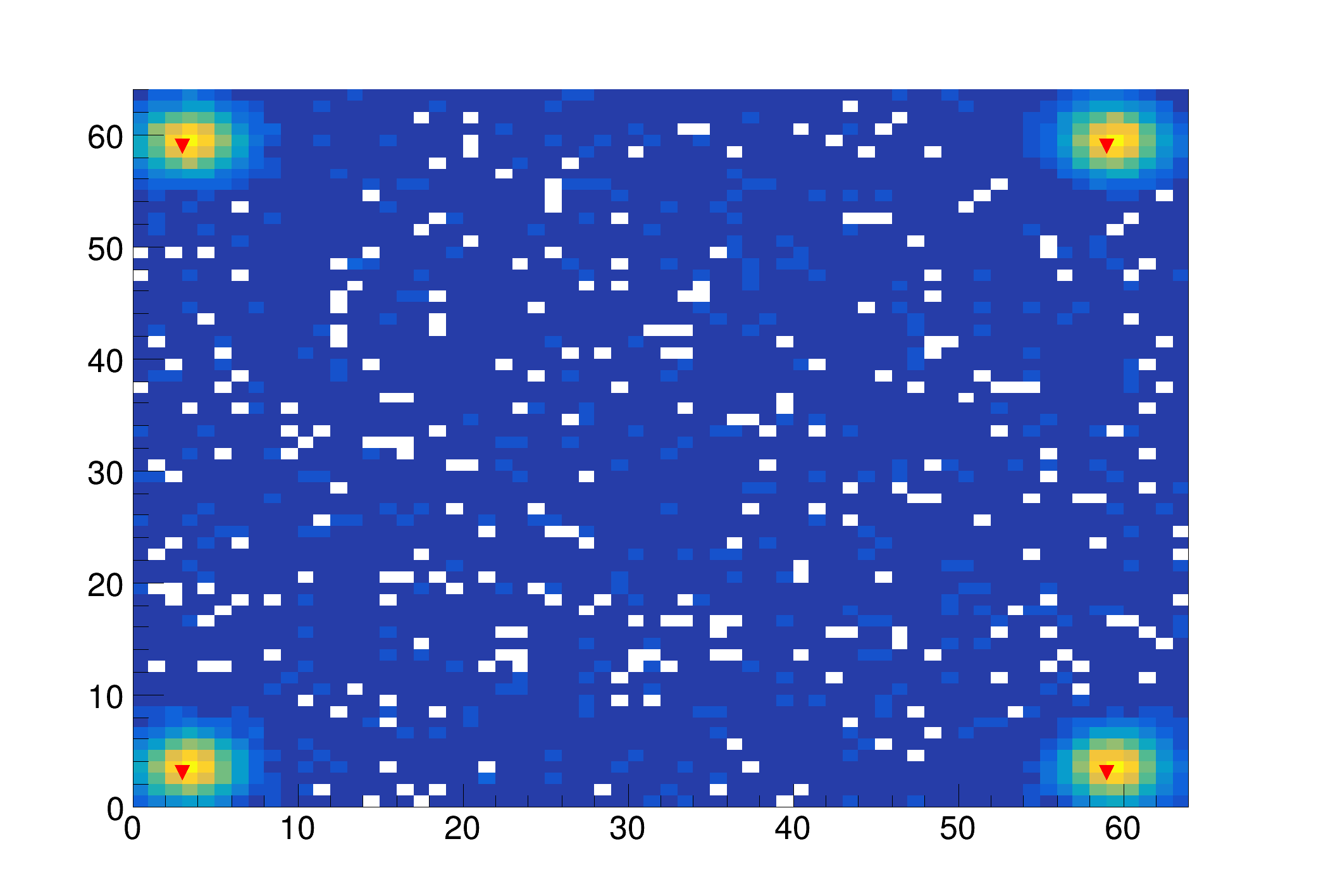
Definition at line 1132 of file TSpectrum2.cxx.
|
static |
static function: Set average window of searched peaks see TSpectrum2::SearchHighRes
Definition at line 106 of file TSpectrum2.cxx.
|
static |
static function: Set max number of decon iterations in deconvolution operation see TSpectrum2::SearchHighRes
Definition at line 115 of file TSpectrum2.cxx.
| void TSpectrum2::SetResolution | ( | Double_t | resolution = 1 | ) |
NOT USED resolution: determines resolution of the neighboring peaks default value is 1 correspond to 3 sigma distance between peaks.
Higher values allow higher resolution (smaller distance between peaks. May be set later through SetResolution.
Definition at line 331 of file TSpectrum2.cxx.
| const char * TSpectrum2::SmoothMarkov | ( | Double_t ** | source, |
| Int_t | ssizex, | ||
| Int_t | ssizey, | ||
| Int_t | averWindow ) |
This function calculates smoothed spectrum from source spectrum based on Markov chain method.
The result is placed in the array pointed by source pointer.
Function parameters:
Goal: Suppression of statistical fluctuations the algorithm is based on discrete Markov chain, which has very simple invariant distribution
\[ U_2 = \frac{p_{1.2}}{p_{2,1}}U_1, U_3 = \frac{p_{2,3}}{p_{3,2}}U_2 U_1, ... , U_n = \frac{p_{n-1,n}}{p_{n,n-1}}U_{n-1} ... U_2 U_1 \]
\(U_1\) being defined from the normalization condition \( \sum_{i=1}^{n} U_i = 1\) n is the length of the smoothed spectrum and
\[ p_{i,i\pm1} = A_i \sum_{k=1}^{m} exp\left[\frac{y(i\pm k)-y(i)}{y(i\pm k)+y(i)}\right] \]
is the probability of the change of the peak position from channel i to the channel i+1. \(A_i\) is the normalization constant so that \( p_{i,i-1}+p_{i,i+1}=1\) and m is a width of smoothing window. We have extended this algorithm to two dimensions.
[1] Z.K. Silagadze, A new algorithm for automatic photopeak searches. NIM A 376 (1996), 451.
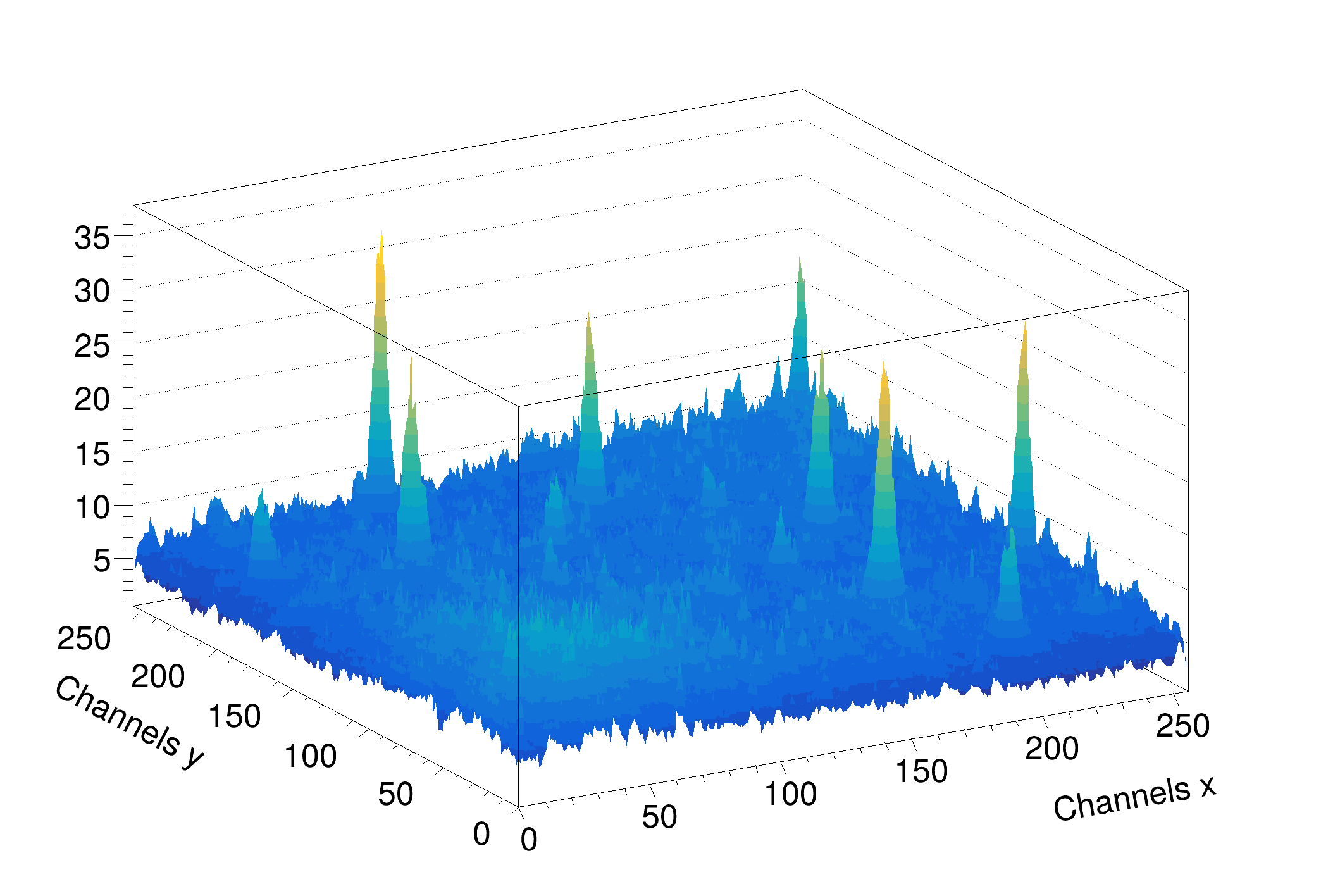
Definition at line 624 of file TSpectrum2.cxx.
|
static |
static function (called by TH2), interface to TSpectrum2::Background
Definition at line 1763 of file TSpectrum2.cxx.
|
static |
static function (called by TH2), interface to TSpectrum2::Search
Definition at line 1754 of file TSpectrum2.cxx.
|
overridevirtual |
|
inline |
Definition at line 61 of file TSpectrum2.h.
|
staticprotected |
Average window of searched peaks.
Definition at line 27 of file TSpectrum2.h.
|
staticprotected |
Maximum number of decon iterations (default=3)
Definition at line 28 of file TSpectrum2.h.
|
protected |
resulting histogram
Definition at line 26 of file TSpectrum2.h.
|
protected |
Maximum number of peaks to be found.
Definition at line 20 of file TSpectrum2.h.
|
protected |
number of peaks found
Definition at line 21 of file TSpectrum2.h.
|
protected |
[fNPeaks] array of current peak positions
Definition at line 22 of file TSpectrum2.h.
|
protected |
[fNPeaks] X position of peaks
Definition at line 23 of file TSpectrum2.h.
|
protected |
[fNPeaks] Y position of peaks
Definition at line 24 of file TSpectrum2.h.
|
protected |
NOT USED resolution of the neighboring peaks
Definition at line 25 of file TSpectrum2.h.